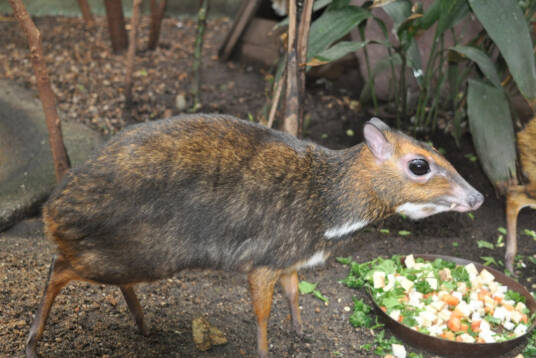Tragulus nigricans
IUCN
LCBasic Information
Scientific classification
- name:Tragulus nigricans
- Scientific Name:Tragulus nigricans, Balabac Mouse Deer,Balabac Chevrotain,Philippine Mouse-deer, Chevrotain de Balbac
- Outline:Ungulata
- Family:Artiodactyls Tragopanidae Tragopan
Vital signs
- length:40-50cm
- Weight:1.5-2kg
- lifetime:About 14 years
Feature
Black throat with three narrow white stripes extending from white chin down
Distribution and Habitat
The Philippine Mouse Deer is endemic to the Philippines and is found only on Balabac, Bugsuk, and Ramos Islands. The species has also been introduced to Apulit and Calauit Islands.
The Philippine Mouse Deer inhabits primary and secondary lowland forests and shrublands, often seen foraging in mangroves and more open areas. On Bugsuk Island, it is found in dense understory coconut plantations.
Appearance
The Philippine mouse deer has a head-body length of 40-50 cm, a shoulder height of 18 cm, and a tail length of 8 cm. It is dark brown overall, with three color bands on virtually every hair: a light base, an orange middle, and a long black tip, the last of which gives the species a black appearance. The underside of the body is slightly lighter, and the inner surface of the legs is white. The black throat is marked by three narrow white stripes extending from the white chin down. The head is generally a darker brown than the rest of the body, with a bright orange stripe between the brows. In males, the upper canines are enlarged into small tusks, which extend past the lip line to form visible "fangs."
Details
Philippine Mouse Deer (scientific name: Tragulus nigricans) English Balabac Mouse Deer, Balabac Chevrotain, Philippine Mouse-deer, French Chevrotain de Balbac, no subspecies.

Philippine mouse deer are territorial in both sexes, with males marking their small, permanent territories with feces, urine, and submandibular gland secretions. They are docile but highly alert, with males slapping the ground with their hooves when harassed, agitated, or angry. Females tend to stay in their territories, while males move around.
Except during the breeding season, the Philippine mouse deer is a very solitary creature, usually active alone, occasionally seen in pairs (male and female or female and cub) or rarely in groups of three. They are nocturnal animals, mostly active at night, seeking shelter in the forest during the day. At night, they forage in more open habitats and often appear on the road under the headlights of vehicles.
In the wild, the Philippine mouse deer feeds on fallen fruits and berries, aquatic plants, leaves, buds, shrubs and grasses.
The Philippine mouse deer was once a subspecies of the giant mouse deer, and its reproductive habits are similar to those of the giant mouse deer in some places. It can reproduce all year round, and the gestation period is 140-177 days. They breed again within a few hours of the birth of their young. They usually give birth once a year, with one young per litter (twins are very rare). The offspring are well developed at birth, standing and fully active 30 minutes after birth. The young are "hidden" by their mother in secluded areas and nursed. The young are weaned at 2-3 months old, reaching adult size at 5-6 months old, and the tusk-like canines of young males can be seen at 10 months. Sexual maturity is around 5 months. The maximum lifespan is 14 years.
The Philippine mouse deer is listed as endangered because its range of occurrence is less than 5,000 km; it lives in three locations on Balabac Island, Bugsuk Island, and Ramos Island. The species is experiencing a continuous decline as it is poached for food and is affected by habitat loss due to the conversion of former habitats to coconut plantations and other agricultural cultivations.
Listed in the IUCN Red List of Threatened Species in 2014 ver3.1 - Endangered (EN).
Protect wild animals and eliminate game.
Maintaining ecological balance is everyone's responsibility!








